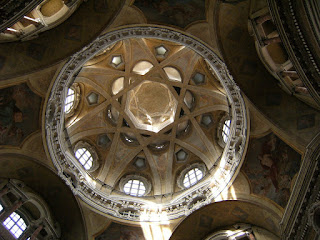First, the beagle. Familiar markings. To get his attention, I extended my camera to him like it was a ham hock.

I’ve been here only two days, but already, Piazza Castello is my morning office. I sit on a bench here and plan my itinerary. A warning: Today’s report is heavy on architecture and churches. It’s part of the necessary progression in Elizabeth Kubler-Ross’ Stages of Vacationing. Stage 1: Walk endlessly to see buildings and generally orient yourself. Stage 2: Walk endlessly in museums. Stage 3: Roam like a beachcomber from one rockpool to another, looking for interesting things to take home. Stage 3 is the most fun, but I’d feel bad if I skipped the first two. From my bench I spy the Torre Littoria, the 21-story red building seen below. It is known by the Torinesi as “L’Obrobrio,” or “The Disgrace,” for upsetting the uniformity of the city’s look. The Fascists, like the Nazis, were intent on expressing their will by constructing buildings on a monumental scale. Turin was a hotbed of anti-Fascism, however (hooray for Communist cement housing blocks!), so you don’t see much of it here.

The 1666 church of San Lorenzo. The royal family wanted a church attached to their private residence, and this is it. Inside, I am all alone. I think briefly about stealing a priceless chalice or icon. But God watches.

The church’s elegantly buttressed dome. Eight windows help illuminate the place. I’ve been to a lot of Turin churches already. All have great natural lighting.

We’re on Via Pietro Micca now, and this is the Palazzo Bellia, created by architect Carlo Ceppi in 1894. The mini-towers hadn’t been possible before, but Ceppi was a pioneer of reinforced concrete, and he pulled it off.

The arcade along Pietro Micca. (Psst: I now think the word “arcade” is correct.)

The Torinesi love their water features. This fella is in the torn-up, pedestrian-unfriendly Piazza Solferino. I think the city has a plan for this space. I hope so, because it’s the only dumpy square I’ve seen so far.

The Piazza San Carlo. I love these wide-open spaces. The occasional delivery truck is allowed to drive through, but otherwise it’s car-free.

Inside the city’s biggest church, the San Felippo Neri.

Looking up, I get the strangest feeling …

omg! I think jesus really likes me!!!!!!!!!!!!

The church’s exterior. I’m calling neo-Classical on the facade, but it doesn’t fit the interior. A late addition?

At first glance, it’s just another piazza (square), but there are some interesting things going on.

For one thing, it’s dominated by this wavy, brick and terra-cotta Palazzo Carignano. Pretty impressive brickwork for the 17th century. But it seems almost modern. Another feather in the cap for Guarini.

A detail of a bow tie/baseball bat/propeller motif on the Carignano.

It’s always something of a letdown when you see a statue like this and come to realize that the guy was a complete nobody. In this case Vinenzo Gioberti, who wrote “The Moral and Civil Preeminence of the Italians.” I guess he was a big shot in the 1840s, but his book didn’t have much of a shelf life. Maybe it was the douche-baggy title.

I got gelato from Pepino’s, considered by some to be the city’s finest. I think I stress too much about this kind of thing, but I practiced all morning. “Oon KOH-no cone DOO-way GOO-stee, pear-feh-voar-ay.” (“A cone with two flavors/scoops, please.”) I need to read up on my “gusti” however. “Cioccolato” was easy enough, but for the second flavor I bailed and just said “strawberry.” Nobody gave a fuck.

The Luxembourg Bookstore, heavy on the English-language books, looks promising. We are still in the Piazza Carignano, where I spent a lot of time. Nice place!

The glass-covered Galleria dell’Industria Subalpina. Offices, shops, cafes. I thought it looked cool.

By the time I was 24 I had read every translated work ever published by Friedrich Nietzsche, so seeing this plaque was special. He lived here at Via Carlo Alberto 6 and wrote some of his greatest books while in Turin: “Ecce Homo,” “The Anti-Christ,” his biography of Wagner. The depressed German philosopher loved Turin, but it’s here that he went crazy. He saw a horse being whipped in the street, tried to protect it, and basically just collapsed. He was insane from that point on and died under his sister’s care 10 years later. Can you say “syphilis”?

A fancy private residence guarded by monsters.

If I were to remark on the similarities between Turin and Paris, I would be the millionth person to do so. So I won’t. But the picture tells the story.

This is disturbing. I know what these flowers mean. They mean that a pedestrian or bicyclist was killed here, right outside my apartment. You really have to keep your head on a swivel in Turin. Trams run on the inside, buses on the outside, speeding cars are everywhere. What looks like a one-way street is actually two-way, etc. Sorry to end on a down note. Did I mention I saw a young beagle? Be careful out there.

That's a young Mulford! Calm spot and everything! You're so damn lucky.
ReplyDeleteHi Peter, I've just discovered your blog (thanks to Shannon at Slowtrav.com). Your phonetic description of asking for gelato was "hee-stair-e-kul"! I really WAS laughing out loud and co-workers were asking "what's so funny" and they all were laughing too! You brought laughter to an otherwise boring xray department! Grazie!
ReplyDeleteYou seem to find humor in everything you do and I think that's fabulous! I leave for Italy in 35 days, I'll be gone for 2 weeks. I wish it were 2 years.
Keep up the great writing!! All the best,
Mindy
Nothing boring about broken bones, Mindy.
ReplyDelete